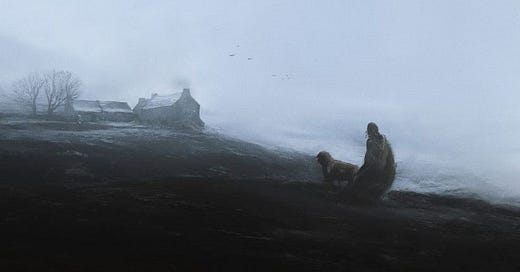One week into February’s pick and the general consensus would indicate that no matter how often you read Wuthering Heights, you never read the same book twice.
For some of us following along with the Gothic Book Club, it’s the first time they have experienced it since high school or early adulthood. Many are coming back to it after years, or even decades. Others are picking it up for the first time.
Perhaps some arrived here because they loved Jane Eyre (written by Emily’s sister Charlotte), or felt they wanted to tackle an oft-mentioned classic. Whatever the reason, the only certainty is that this book contains surprises and ever-changing forms.
Age, experience, mood and perspective will inevitably alter your perception of any work of art, but there’s something so indeterminate when it comes to Wuthering Heights. Alliances and preferences shift around the story at breakneck speed, playing upon the complexities of human emotion. Sometimes, when you read an author from this era, you get a sense of character. Charles Dickens, for example, is wonderful at creating strong, memorable characters. In Emily Brontë's work, however, it feels more like we’re getting to know people.
What kind of atmosphere does Brontë establish in these opening chapters? How does the setting contribute to the novel’s mood?
Heathcliffe is introduced as an imposing, aloof, dramatic figure, but it doesn’t take long to learn about the complexity of his background, and what led him to hold his current position. That is, if our narrators are to be wholly believed. Given that we are led through the story by several perspectives, it puts more weight on the reader to cut through any potential bias to find the truth of the tale. Lockwood even initially believes he and Heathcliff are alike in their introversion, which is an amusing take to say the least.
How does Lockwood function as a narrator? Does his perspective shape how we view Heathcliff and the other inhabitants?
We are given the dynamics, as well as a dreary tour through Wuthering Heights as it now stands. We are also introduced to Catherine by means of her old books and…quite possibly, her ghost.
Catherine’s ghostly presence is a striking moment in Chapter 3. Do you believe the ghost is real, or is it a psychological manifestation of Heathcliff’s grief?
Consider these questions as we traverse the opening chapters. Please add your favourite quotes to the comments, either here or on Fable.





I love the setting of Wuthering Heights, all tangled in prickly gooseberries with those narrow windows that I can picture so well. In the early chapters, the wind seems to forebode events, and the house windows are portals through to what is always on the "other side", which, depending on your perspective, is trying to get inside of the house or outside of the house. Where is the safest place to escape a haunting?
As to whether Catherine's ghost is real? Based on the text, if I ask myself if Catherine's ghost is 'real' objectively, I can't answer that for myself, never mind the characters in a novel. I believe that the characters who report seeing the ghost perceived and experienced a real phenomenon, one that involved an apparation of Catherine. Whether ghostly Catherine is conjured within the haunted mind of the perceiver or by external forces that we don't fully understand, I don't know. The uncertainty is a mystery that I am happy to wait for the answer to when it's time to move on from this life. What's your take, Colin? Is Wuthering Heights haunted?
I think at this point in the novel (certainly if you were reading for the first time) the question of whether the ghost is real is less relevant as to why there might be a ghost in the first place. So it's not something that needs answering right now and more a conclusion to be reached further along.